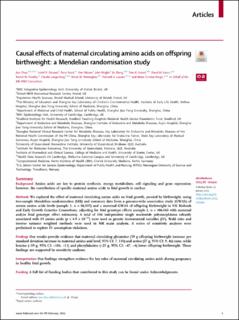| dc.description.abstract | Background
Amino acids are key to protein synthesis, energy metabolism, cell signaling and gene expression; however, the contribution of specific maternal amino acids to fetal growth is unclear.
Methods
We explored the effect of maternal circulating amino acids on fetal growth, proxied by birthweight, using two-sample Mendelian randomisation (MR) and summary data from a genome-wide association study (GWAS) of serum amino acids levels (sample 1, n = 86,507) and a maternal GWAS of offspring birthweight in UK Biobank and Early Growth Genetics Consortium, adjusting for fetal genotype effects (sample 2, n = 406,063 with maternal and/or fetal genotype effect estimates). A total of 106 independent single nucleotide polymorphisms robustly associated with 19 amino acids (p < 4.9 × 10−10) were used as genetic instrumental variables (IV). Wald ratio and inverse variance weighted methods were used in MR main analysis. A series of sensitivity analyses were performed to explore IV assumption violations.
Findings
Our results provide evidence that maternal circulating glutamine (59 g offspring birthweight increase per standard deviation increase in maternal amino acid level, 95% CI: 7, 110) and serine (27 g, 95% CI: 9, 46) raise, while leucine (−59 g, 95% CI: −106, −11) and phenylalanine (−25 g, 95% CI: −47, −4) lower offspring birthweight. These findings are supported by sensitivity analyses.
Interpretation
Our findings strengthen evidence for key roles of maternal circulating amino acids during pregnancy in healthy fetal growth.
Funding
A full list of funding bodies that contributed to this study can be found under Acknowledgments. | en_US |

